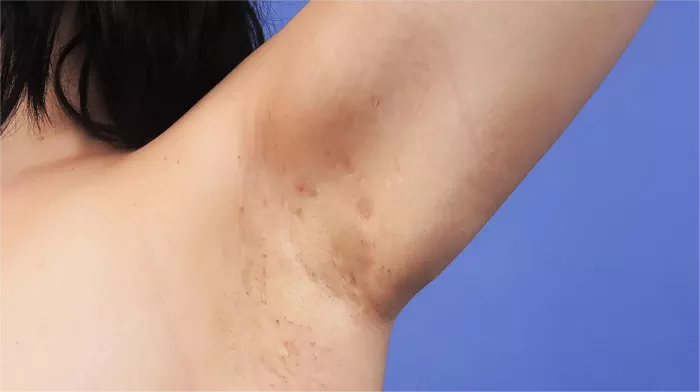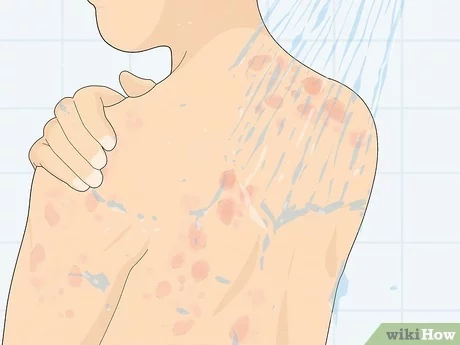Hidradenitis suppurativa (HS) is a chronic inflammatory skin condition characterized by painful, pus-filled bumps or boils. This condition primarily affects areas of the body where skin rubs together, such as the armpits, groin, buttocks, and under the breasts. Despite being a common yet often misunderstood condition, HS requires lifelong management due to its chronic nature. Below is a comprehensive overview of HS in the armpit, covering its definition, symptoms, causes, diagnosis, treatment, and how to live with the condition.
Definition and Explanation
Hidradenitis suppurativa (HS) is a chronic inflammatory disorder of the skin, primarily affecting areas where hair follicles are abundant and where there is friction between skin surfaces. This condition is marked by the development of painful lumps, abscesses, and tunnels under the skin, which can lead to scarring and significant discomfort.
The armpits are one of the most commonly affected areas by HS due to the presence of apocrine glands, which are sweat glands associated with hair follicles. These glands can become blocked and inflamed, leading to the formation of painful, pus-filled bumps. The inflammation in HS is chronic, meaning it persists over time, often with periods of flare-ups and remission. This chronicity makes HS a lifelong condition that necessitates ongoing management and treatment.
Symptoms of HS
The symptoms of HS vary from person to person, but the condition generally progresses through different stages, starting with mild symptoms and potentially advancing to more severe complications.
Painful Lumps: The first sign of HS often includes small, pea-sized lumps under the skin. These lumps are painful and can persist for weeks or even months.
Boils and Abscesses: As the condition progresses, these lumps may enlarge, forming abscesses or boils filled with pus. These can rupture and drain, leading to foul-smelling discharge.
Scarring: Recurrent episodes of inflammation can cause permanent scarring, with thick, fibrous tissue forming where the skin heals from previous lesions.
Inflammation: The affected areas, particularly in the armpits, can become red, swollen, and extremely tender due to ongoing inflammation.
Drainage and Odor: Chronic drainage from the abscesses, combined with bacterial growth, often leads to an unpleasant odor, which can be distressing for those affected.
Potential Complications: HS can lead to several complications, including chronic pain, severe scarring, and the formation of fistulas (abnormal connections between different body parts). In rare cases, long-term inflammation may increase the risk of skin cancer.
Causes and Risk Factors
The exact cause of HS remains unknown, but it is believed to result from a combination of genetic, hormonal, and environmental factors.
Genetics: A family history of HS increases the likelihood of developing the condition, suggesting a genetic predisposition.
Hormones: Hormonal fluctuations, particularly during puberty, menstruation, and menopause, may trigger or worsen HS symptoms.
Obesity: Excess body weight can increase friction between skin surfaces, exacerbating the condition.
Smoking: Tobacco use has been strongly associated with the development and severity of HS.
Friction: Constant rubbing of the skin, especially in areas like the armpits, can contribute to the onset and worsening of HS.
While these factors can increase the risk of developing HS, not everyone with these risk factors will develop the condition, and some individuals may develop HS without any known risk factors.
Diagnosis and Treatment
Diagnosing HS is primarily clinical, based on a physical examination and the characteristic appearance of the skin lesions. A dermatologist will evaluate the symptoms, the frequency of flare-ups, and the presence of any related conditions, such as acne or Crohn’s disease. In some cases, a biopsy may be performed to rule out other skin conditions.
Treatment Options:
Topical Medications: Antibiotics and antiseptic washes may be prescribed to reduce bacterial load and inflammation.
Oral Antibiotics: In cases of moderate to severe HS, oral antibiotics are often used to control infection and inflammation.
Biologics: These advanced medications target specific components of the immune system to reduce inflammation. Adalimumab (Humira) is one of the FDA-approved biologics for HS treatment.
Surgical Procedures: For severe cases, surgery may be necessary to remove affected tissue, drain abscesses, or repair fistulas.
Professional Care: Self-diagnosis and treatment of HS are not recommended due to the complexity and chronic nature of the condition. It is essential to seek care from a dermatologist who can tailor a treatment plan to your specific needs.
SEE ALSO: What Foods Cause Hidradenitis Suppurativa?
Living with HS
Managing HS involves more than just medical treatments. It requires lifestyle adjustments and ongoing self-care to minimize symptoms and improve quality of life.
Hygiene Practices: Keeping the affected areas clean and dry is crucial. Use gentle, fragrance-free cleansers to avoid irritating the skin.
Avoiding Irritants: Wear loose-fitting clothing to reduce friction and avoid tight clothing that can exacerbate symptoms.
Warm Compresses: Applying warm compresses can help reduce pain and inflammation during flare-ups.
Diet and Weight Management: Maintaining a healthy weight and avoiding foods that may trigger inflammation can help manage symptoms.
In conclusion, Hidradenitis suppurativa in the armpit is a complex, chronic condition that requires a multifaceted approach to diagnosis, treatment, and daily management. Understanding the symptoms, causes, and treatment options is essential for those affected by HS, and professional care is critical in managing this challenging skin condition.
Related Topics:

























